Bordeaux Famous Wine villages Paintings Explained
This series is special because there is no shortage of landscape paintings in the Bordeaux region.
Never before has a painter made a series about the villages behind the famous names.
Welcome to the ![]() Bordeaux, “Picturesque Wine Villages Series of paintings”
Bordeaux, “Picturesque Wine Villages Series of paintings” ![]()
Bordeaux, then, now, tomorrow, the most famous name in the wines of the world.
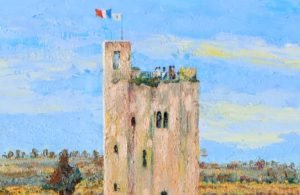
Beside others things, the Bordeaux region is also known for its beautiful villages and it’s gourmet foods and intriguing, long history.
Bordeaux wine region is located on the Atlantic coast, on right and left bank of the Gironde Estuary.
Bordeaux is famous for its unique red wines which include clarets however there is a great diversity of light and easy-drinking whites as well.
Bordeaux wines have been ordered by the Kings of England at least as far back as Henry II ‘comte d’Anjou et du Maine, duc de Normandie et d’Aquitaine et roi d’Angleterre’ .
When you visit Bordeaux, dedicating at least a day or two to its exquisite countryside is a must.
Many factors make Bordeaux very special.
You can fly directly from many destinations and land close to the city centre and vineyards.
Bordeaux is the capital of Gironde, the biggest department in France with a huge variety of places to visit and things to do.
Contents of this page :
Organised via the drop down menu above, each region is introduced by its own homepage with an illustration of each painting linked to individual painting pages and in many cases, links to ‘further reading’.
Sub home links; your keys to open this evolving series :
C. V. / résumée

An opportunity for you and me to share ideas, inspiration, a dream.
The vineyards and chateaux of Bordeaux have been much painted, never though a series about the villages.
People, many, know the name ‘Bordeaux’ and they are curious to learn more.
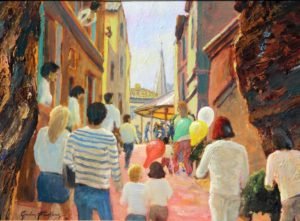
Bordeaux-Picturesque-WineVillages, a modest beginning, a grand project.
Via this collection you can share an experience in a non technical, entertaining way, memorable images, engaging, surprising texts, through the eyes of this artist.
Bordeaux wine region: you know the name, you’ve probably heard of some of the wines and foods; this ambitious project offers you an artist’s eye insight, a memorable, tantalizing look at many of the famous towns and villages, join me for a voyage into the Bordeaux region, Bordeaux, wine and art, three magic words, enjoy.
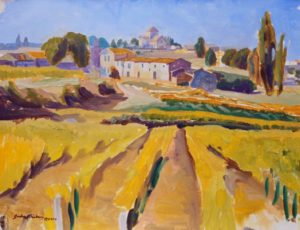
The wine village names roll off one’s tongue with a special fluidity: St Emilion, Sauternes, Pauillac, Cadillac, Sauveterre, Medoc, Entrée deux Mers, Graves, Canton de Blaye, Castillon la Bataille, many more; and the associated region of Gaillac.
This collection has not yet been exhibited in public; there is a problem; people buy the paintings.
Fortunately, with such a diverse, rich subject, I can and am painting more to create a really memorable exhibition.
Meanwhile you have a special preview here, an artist’s personal introduction to the glorious Bordeaux region through the rich colours and thoughtful compositions of Gordon Frickers paintings.
An opportunity for you and me to share
Trails on the Internet and by personal contact strongly suggest anyone who eats and drinks will want to attend this exhibition preview (vernissage), it’s even been called “the vernissage to end all vernissage!”
These ‘wine art’ paintings make a great introduction, an unusually attractive core for the public and press, an exhibition together with products of the region suitable for prestigious locations.
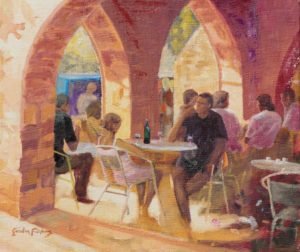
The Bordeaux region :
is dominated by the great chateaux and famous wines, subjects popular with many artists including some of the most famous, Picasso for example.
This particular project is more ambitious in it’s extent so has never been attempted before.
No one has focused on the villages, small towns, their idiosyncrasies, vitality, their charm.
Exhibition venues suggested by a previous Head of Tourism, Saint Emilion, include Paris, London, Monte Carlo and New York.
I don’t want to organise a major exhibition, I’m a painter.
Thus if you or someone you know is an organiser, publicist, there is a rather special opportunity here for us to work together possibly with a famous chef, with TV, radio; for sure there are possibilities including for a sponsor.

Bordeaux and the Garonne.
The city and it’s famous quays are built on the banks of this substantial estuary some 100 kilometres from the wide and often wild Atlantic Ocean.
Thus the city is in an ideal location to act as interlocutor for trade with the hinterlands and wider world which historically meant northern Europe in particular England and later the United States of America.
The Bordeaux region is elegantly divided into two main parts by the substantial and tidal rivers of the Garonne and Dordogne which merge to create the picturesque estuary of The Garonne.
This division also defines the style of Bordeaux blends and splits Bordeaux into distinctive territories that are must-visit while you are travelling in the region. The Left bank area includes famous appellations such as Médoc, Graves, Margaux, and Pauillac, where Cabernet Sauvignon is the predominant grape variety whereas on the Right bank you will find Saint-Émilion, Pomerol, Libournais, and Bourg and Blaye with the dominance of Merlot.
There is a Left Bank and a Right Bank to the rivers with a territory between two rivers called Entre-Deux-Mers which translates as land between two seas.
Entre-Deux-Mers is so called because the rivers are very tidal Bordeaux includes 57 appellations(AOC) and 38 sub-regions.
These regions combine to make Bordeaux the largest appellation wine producer in France.
However the renown of Bordeaux wines is not founded on the size of it’s region, rather on it’s location and significantly, on its development since ‘The Dark Ages’ during which period the Roman vinyards and extensive settlements were reduced to ruin by barbarians the last of whom were Norsemen, Vikings.
The main grape varieties used in the production of world-known Bordeaux wines are Merlot and Cabernet Sauvignon, often accompanied by Cabernet Franc and Petit Verdot. Bordeaux wines produced of these red varieties are globally recognized as “Bordeaux Blend”. Even though 90% of the wine produced here is red, there as well exists a white Bordeaux blend – its primary grapes are Sauvignon Blanc and Sémillon.
Muscadelle is also involved in this blend in some cases.
Bordeaux has a very unique and specific way of trading wine, which makes it traditional and modern at the same time.
Benefiting from the location and the climate Bordeaux vineyards here produce exclusive wines. Worldwide recognized for its harmonious, premium quality wines, Bordeaux is a major player in the international wine market. Moreover, the city of Bordeaux is one great wine capitals famous for its historical heritage and outstanding gastronomical scene.
Bordeaux divided by the Gironde Estuary.
The right bank of the Bordeaux wine region includes renowned wine appellations such as Pomerol and Saint-Emilion. Wines produced here unlike left banks are more Merlot-based, with Cabernet-Franc, Cabernet Sauvignon, Malbec, and Petit Verdot used in blending. Bordeaux wines from the right bank are more fruity, lower in acidity, and tannins. Visiting Saint-Emilion is a must for everyone travelling to Bordeaux. Later you will discover what makes this little village so special.
Keep in mind, that Bordeaux is not only about high-end wine-producing Châteaus. There are around 8000 Châteaus around the region and you can find high-quality Bordeaux wines in every price segment.
the origins of the city are much older and date back to Gallo-Roman times. The tourist office organizes guided tours to tell you about this distant past.
Saint-Emilion
Saint-Emilion is famous for its huge vineyards, the quality of wines, architecture, and cultural heritage.
The town has incredible architecture and a great history.
discover the largest monolithic church in Europe, the catacombs, Chapel of Trinity! Saunter in the village in a couple, or with your family and friends to discover its amazing landscapes and visit surrounding Bordeaux vineyards!
After exploring the heritage of Saint-Emilion, you can visit wineries in the surroundings of the village!
Gastronomy in Bordeaux Wine Region.
Discover Culinary Specialities in Bordeaux. The location as a port and a trading city has affected the peculiarities of its gastronomy. Bordeaux wine region’s gastronomical scene is pretty diverse. You will find everything from high-end gourmet restaurants and bistros to wine bars and marketplaces, where you can taste authentic food and products. Here you will find the three most characteristic dishes that represent the region the best.
Wines of the Left Bank – Peppery & Tannic
The wines of the Left bank (particularly, Medoc and Graves wine regions) display fruit aromas and flavors of berries as well as dark cherry, vanilla, and coffee beans. The Bordeaux wines here are spicier and have also peppery flavors and bold tannins. The major factors, which influence the characteristics of these wines, are soils and the favorable climate of the territory (clement winter and hot summer). Cabernet Sauvignon is a primary grape in the blend of the Left bank wines. It is also responsible for the powerful characteristics of the wine.
Medoc gathers many renowned appellations as well as Grand Crus – French wine classification level given to the wineries of the most superior grade with the highest excellence Bordeaux vineyards.
With these paintings and articles I present for you some of the most beautiful villages in Gironde which are perfect places begin to discover the architecture and heritage of the region.
most villages on this list require a car to get to, in case you don’t have one be reassured it’s easy to rental car in Bordeaux and companies like Eurocar are good value.
Saint Emilion
Can you really make a list of villages around Bordeaux without including Saint Emilion in it?
This medieval village is known all around the world for its splendid wine but it’s also undoubtedly one of the most beautiful villages around Bordeaux.
Important historical monuments can be found in abundance in this medieval town, some of which date back as far as the 11th and 12th centuries. One of the famous monuments is the 11th-century Monolithic church, carved from a limestone cliff, it’s the largest underground church in Europe.
Its picturesque centre, densely filled with wine shops and fancy restaurants, turns this little town into a prominent tourist attraction. I
f you’re visiting Saint Emilion in the high season of July-August beware that you need to book everything in advance, it is rightly very popular!
There are plenty of things to see in and around Saint Emilion, and it requires the minimum of a full-day trip to see all of it.
The village of Saint Emilion, a true medieval town, is in the heart of the famous Bordeaux vineyards. It is thus more than two thousand years of history between men and the vine that you will be able to appreciate. Take the time to visit, discover and enjoy the beauty of the landscape of this historic vineyard still intact today. Guided tours of the village, walks, wine tourism, discover Saint Emilion!
A harmonious work of Nature and Man, the landscapes of Saint-Émilion are unique testimonies of History.
In 1999 and for the first time in the world, a wine landscape was ‘promoted’ to the ranks of World Heritage sites by UNESCO which rates Saint-Émilion as “a remarkable example of a historic wine landscape which survived intact ” and which continues its activity today.
I recommend reading my guide to Saint Emilion before heading there. Also, if you want to visit wineries in the Saint Emilion wine region, check out my article about the best wineries to visit in Saint Emilion.
A guided tour to Saint Emilion that will include both the town and the wineries is both good value and very memorable.
Blaye
Blaye is one of the most interesting places in the Bordeaux area, located only about 50 km north of Bordeaux. This little town has a long military and strategic history and is mostly known for its remarkable Citadel.
The Citadel and city walls are recognized as a UNESCO World Heritage Site and you can easily spend half a day discovering them. The entrance to the Citadel is free and you can explore the streets and ramparts admiring the view of the Gironde estuary which can be seen from the top.
Blaye is also well known for its red wine which I really like and find reasonably priced. You can visit the Maison du Vin on the main street (12 Cours Vauban), where they would gladly introduce you to the wines of the region and the chateaux you can visit around Blaye.
How to get from Bordeaux to Blaye?
The easiest way to get there is by car or by ferry if you’re coming from the other side of the Gironde estuary. The ferry is leaving from Lamarque, you can see all the details about the tariffs and hours in this link.
Bourg
Bourg (Previously called Bourg sur Gironde) is a picturesque village, located at the confluence of the Dordogne and Garonne Rivers. Playing a key role in the region’s history, Bourg was fortified by the English and visited by several kings, such as Louis XIV in 1650. Just like its neighboring town of Blaye, Bourg also has a very impressive citadel called Château de la Citadelle.
Apart from the citadel, the historic part of the city has a cute central square with restaurants and shops, the market takes place every Sunday.
Bourge is also known for its great wine, labeled under the Côtes-de-Bourg appellation. Don’t miss a visit to the Maison des Vins, a 19th-century former residence with a warm atmosphere that acts as a venue for exhibitions, talks, receptions, tasting classes, meetings with winegrowers, and more. You can also see the map of all the wineries here, it’s better to call them before your visit.
Whether you decide to go to Blaye or Bourg, I highly recommend staying at the stunning Domaine La Corniche located in between the two towns.
If you want to discover all the other amazing places to visit around the Bassin d’Arcachon check out my blog about visits to the Bassin d’Arcachon and Dune de Pila.
Entre-Deux-Mers – “Between Two Seas”.
Entre-Deux-Mers means “between two seas/tides” but actually, the territory lies between the Dordogne and Garonne rivers.
This is one of the most beautiful parts in the south west of France embodying the historic and cultural richness.
Located in the South East of Bordeaux, Entre-Deux-Mers occupies 7000 hectares, which makes it the largest winemaking area of the Bordeaux.
Most of the villages on my list are located close to one another so you can visit them all in one weekend. Public transport is not extremely developed in this part of Gironde so it’s better to travel by car or bike if you like cycling a lot. I did, however, add public transport routes to these places just for completeness.
If you fancy a romantic weekend in that part of Gironde, check out Château Lafaurie-Peyraguey, one of the best wine hotels in the region.
The huge diversity of soils in this wine area allows the production of red and white wine. Here, they produce dry and sweet white Bordeaux wines from Sauvignon and Sémillon grapes. To produce high-quality red Bordeaux wines, wine-growers use the Merlot.
Entre-Deux-Mers wines are well-balanced and crispy with pale golden color. Normally, they are consumed young but they can be aged well thanks to Sauvignon Blanc’s potential.
Even though Bordeaux is a unique region mainly known for its full-body red wines.
A wine enthusiasts can find in Bordeaux Entre deux Mers wines some common aromas with wines from Italian red wine region, Chianti.
When harvested early, both Merlot and Cabernet Sauvignon from Bordeaux have strong red currant notes – the same happens with Sangiovese wines from Chianti.
Red wine lovers often choose Chianti and Bordeaux as their top priorities for wine tasting and tours.
Cadillac in the Graves region.
Cadillac is a little town located on the right bank of the Garonne River in the Entre Deux Mers wine region. It’s quite a popular destination attracting many tourists, especially during summer. Cadillac is hard to miss when driving the D10 route to the south of Gironde. You will be greeted by a big defensive wall and the main gate into the old medieval center built in the 13th century.
However, its undeniably most famous monument is the Château des Ducs d’Épernon, built by the Duke of Épernon in the 17th century. The chateau is very impressive and is best known for being a women’s prison starting from the French Revolution up until 1950.
It now serves as a museum that mostly displays the life of the royals who were occupying the estate before it became a prison. However, on the last floor, you can still see the cells and a small exhibition about the prison.
Cadillac is a Bastide in Entre-deux-Mers, dating from 1280. It has managed to preserve its heritage over the centuries, which makes it a favorite village for lovers of old stones.
You can visit its 12th century ducal castle, its 18th century Charterhouse, which today houses the Maison des Vins, and its central square, with the Halle, built in the 19th century. Cadillac is also known for its local farmers’ market, which has been held there every Saturday for over 800 years now.
Castelmoron d’Albret.
A tiny medieval village claiming to be the smallest village in France is brimming with charm.
Almost every house here is covered with beautiful, scented roses and other picturesque flowers spilling from the eclectic pottery that is made here in the village.
No house here looks the same, every window and door has its particularity. There are almost no signs of modern life here, no cars, just a beautiful village frozen in time.
Only about 50 people are living here and only three businesses operate in the 3.5 hectares village so the atmosphere is incredibly relaxing.
I recommend visiting the impressive bastide town of Sauveterre-de-Guyenne, which is located just a few minutes drive from Castelmoron d’Albret.
There are also several hiking and cycling routes you can do in this part of Entre deux Mers. In this link, you can find a great hiking trail that starts from the village itself.
Château Lafite Rothschild, Medoc region.
Château Lafite Rothschild has a fascinating history that goes back to 1234.
The wine estate is an honourable member of the five châteaux referred to as the ‘first growths’.
They produce Bordeaux wines that with exceptional finesse and elegance that are great as young but also have significant ageing potential.
Many believe that Bordeaux produces only red wine blends. However, Sauternes, a famous village, situated in the South West of Bordeaux, is known for its high-quality sweet white wines.
Sauternes is the king of white wines.
Sauternes is queen of the Graves region.
Crossed by the Ciron, the vineyard benefits from the combination of heat and humidity, that’s why the bacteria Botrytis Cinerea appear.
This bacteria allows the development of a beneficial fungus that causes shrivelling grape berries, which results in concentrating the sugar and flavour content.
This is responsible for the characteristic flavour of Sauternes wines.
Sauternes wines shine with desserts as well as it expresses their brilliant character with foie gras.
To ensure the wines are ideal, up to 7 hand picking passes are made during the autumn, to guarantee the exceptional qualities of the wines and some very good news, the younger Sauternes are affordable and improve with age.
Better still, at the ‘Maison de Sauternes’ you can sample for free 40 plus different Sauternes wines.
Exhibition Ideas, Ambition, a Dream
it has been suggested by a former head of tourism at Saint Emilion that these paintings exhibited together with products of the region, with wines and food tasting at the preview, will create an event many people will be asking to be invited to saying “this will be an exhibition not to miss, with a preview (Vernisage) not to be missed, the vernissage to end all vernissage!”
Here You also have an opportunity to purchase or commission one of these exceptional paintings for your collection.
Contact
T : Mobile + 33 (0) 6 10 66 19 26
or Whatsapp ‘gordonfrickers’
Email: info at frickers.co.uk
People, many, are curious.
People worldwide have heard of Bordeaux wines, here you can begin to answer the question, why is Bordeaux so renowned?
The Bordeaux region is richly endowed with charming, distinguished villages, communes and towns with long histories and bright futures.
The name ‘Bordeaux’ is known throughout the world, yet few have seen this extraordinary region, fewer still know it well.
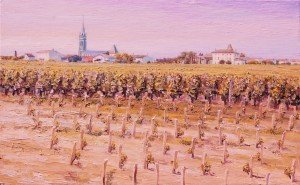
Bordeaux has a unique trading history past and present being the only wine growing area in France not developed after ‘The Dark Ages’ by the church.
Many people know of the famous names associated with Bordeaux quality wines but don’t know the individual villages.
Each Bordeaux village and small town has it’s own ambiences, the attractions are considerable, the histories, the present and future entertain and challenge our palettes, our imaginations.
With a wealth of inland rivers and canals, Bordeaux has been the principal port for many of the South West wines.
Bordeaux with its port and extensive quays, has a very long tradition of trading worldwide particularly enjoying a very long special relationship with England, The Netherlands, the USA and Germany.
T : Mobile + 33 (0) 6 10 66 19 26
or Whatsapp ‘gordonfrickers’
Email: info at frickers.co.uk
A modest beginning, an ambitious project:
This project started in Brest, in Brittany, in the best possible (French) way at a dinner table some years ago with French friends who realised I have an affinity inherited from my Father for good food, ‘interesting’ wine and an admiration for French culture and people.
Joel and Marie These Linquette suggested “why don’t you paint the famous French wine villages”?
I quickly realised the most suitable region to make a start was Bordeaux, and of course it was necessary to repeatedly visit the region, meet interesting people and of course, sample the produce.

While painting at St Emilion I found myself introduced to the Head of Tourisme who was quick to see the project had wider implications, could add value to the entire region potentially benefiting many people.
Looking beyond my immediate concerns, he suggested the paintings form a core for an exhibition or more together with products of the region; Paris, London, New York, Monaco were mentioned. Thus we have an opportunity for an exhibition manager and for sponsors.
Gordon Frickers, is a distinguished artist of 35 + years experience: example, one of the very few invited to exhibit at the European Parliament (May 2011).
C. V. / résumée
I have visited the Bordeaux region many times over the past 20 years, learning, sketching, researching, photographing, painting on locations, making contacts and in some cases friends, most recently May / June 2014.
I must be over due another visit to the Bordeaux region.
Care to accompany me?
Landline : + 33 (0) 9 79 01 93 20
Mobile : + 6 10 66 19 26, E : artistfrickers at gmail.com
WhatsApp, Telegram.com or Facebook Messenger to ‘gordonfrickers’
Email: artistfrickersatgmail.com : note, the ‘at’ is to fool robots and should be replaced with @ : if it arrives I always reply.
Websites : www.frickers.co.uk/art (marine & aviation)
& www.artfrickers.com (Landscapes & portraits).
Copyright 2022 and legal moral rights for painters
Sharing my pages and posts for private use helps everyone.
For commercial use our Fees and Terms are among the most generous on the Internet.
Don’t hesitate to ask for details.
Gordon Frickers © updated 06.04.2024
You are cordially invited to follow and share on your posts, The Art of Gordon Frickers, his blog or www.facebook.com/gordonfrickers.

